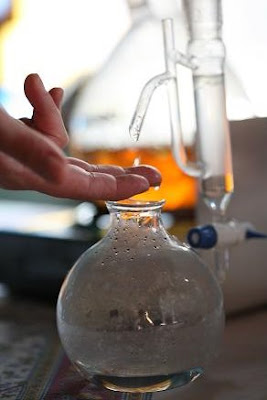For this distillation, we used hyssop. The hydrosol will be used in a syrup for respiratory problems. It was amazingly fragrant. A bit of a surprise, actually. Pleasantly so.
 Above, I am adjusting the clamp that will hold the condenser during the process.
Above, I am adjusting the clamp that will hold the condenser during the process. The bottom flask has begun to boil and steam is just beginning to build in the bottom of the bioflask.
The bottom flask has begun to boil and steam is just beginning to build in the bottom of the bioflask. Sarah and I look intently at the separater from opposite sides of the table. The ball shaped collection flask is nearly full of distillate, cloudy with the particles of essential oil that will remain emulsified in the water.
Sarah and I look intently at the separater from opposite sides of the table. The ball shaped collection flask is nearly full of distillate, cloudy with the particles of essential oil that will remain emulsified in the water. We catch a drop to taste.
We catch a drop to taste.Below, a single drop falls into the collection flask.
 In the bowl, a pump runs icy water through the condenser and returns it to the bowl warmed from the steam in the center of the tube. I've learned to fill the bowl mostly with ice. Usually the distillation is nearly done by the time the ice melts. I'm answering questions and explaining the process while it occurs.
In the bowl, a pump runs icy water through the condenser and returns it to the bowl warmed from the steam in the center of the tube. I've learned to fill the bowl mostly with ice. Usually the distillation is nearly done by the time the ice melts. I'm answering questions and explaining the process while it occurs. The pale yellow layer on the top is essential oil. There isn't a lot, but considering that many times we get no oil, this is a good bit for this size still. My still is mostly good for the hydrosol.
The pale yellow layer on the top is essential oil. There isn't a lot, but considering that many times we get no oil, this is a good bit for this size still. My still is mostly good for the hydrosol.
The valve at the bottom lets me release the hydrosol while trapping the essential oil. It isn't perfect, and I usually get a drop or two of the water.  Here you get an idea of the quantity of essential oil that was produced.
Here you get an idea of the quantity of essential oil that was produced.
 Here you get an idea of the quantity of essential oil that was produced.
Here you get an idea of the quantity of essential oil that was produced.
 I'm not sure how instructional this is, but I just love the way Lori captures the light and colors.
I'm not sure how instructional this is, but I just love the way Lori captures the light and colors.